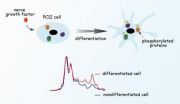(Press-News.org) Everyone wants to present themselves in the best light - especially when it comes to finding a partner. Some rely on supplying honest information about their attributes while others exaggerate for good effect. A new study by researchers at the University of Bristol, published in PNAS, has discovered how male crickets could use similar tactics to attract a mate.
Male crickets advertise for mates by singing loud repetitive songs at night. They rub their wings together, setting them into resonant vibration, making a loud and intense sound, which enables the female crickets to locate them. The females also use this sound to establish which males are the most desirable. There are many cues they can use to gauge desirability, but there is one that everyone thought could never be faked, size.
Female crickets tend to prefer large males; the speculation is that they are somehow better at finding and using resources, and hence their size reflects their advantageous genes. Males that are larger make lower pitched sounds, and smaller ones have a higher pitch. Females can simply listen and gauge the size of the male. The males, it was thought, could do nothing about it and always sang at only one frequency, because of the inflexible mechanics of singing. It was then discovered that tree crickets — tiny, nearly transparent and highly unusual creatures — change the pitch of their song with temperature.
One species Oecanthus henryi sings at a squeaky high pitch of 3.6 kHz when it's a balmy 27 degrees C and a deep bass 2.3 kHz when it's 18 degrees C. However, no one really knew how they managed this or even why they did it - until now.
In a collaborative study, scientists from the University of Bristol and the Indian Institute of Science began to investigate these curious biomechanics. They used a sophisticated technique called microscanning laser Doppler vibrometry, which can pick up tiny vibrations. The technique is so sensitive that it can detect motion that is smaller than atomic bond lengths. While the tree cricket's wings vibrated more than that; the researchers found that the pattern of vibration was unusual. The whole wing vibrated instead of just a small part and instead of having a single sharp vibratory peak near song frequency, there were two fused peaks.
Dr Natasha Mhatre, lead author on the study and an expert in the biomechanics of singing and hearing in insects at Bristol's School of Biological Sciences, said: "The unusual long shape of their wings has always intrigued us. Using a method called finite element modelling, borrowed from engineering; we were able to show that geometry is key. As wings go from short to long, different vibratory modes start coming closer in frequency and amplitude and start merging with each other. "
When a tree cricket is singing, its wings cannot be locked into a single vibrational mode or frequency and it vibrates at a range of frequencies. Because they are cold-blooded, the activity of insects is highly influenced by temperature. Hence, when the temperature rises, tree crickets are more energetic and call faster and engage a higher frequency mode. What this means is that their size is no longer related to their song frequency but to how fast the tree cricket is able to move its wings. This opens up many possibilities for these unique crickets including using song to disguise their true size. Whether they do, however, remains to be seen.
The analysis shows a turn in the story at this point. The researchers found that the most probable reason for changing the geometry of their wings by making them bigger is to increase the amount of sound they can make.
Dr Mhatre added: "Sometimes understanding how something works is crucial to understanding why it works that way. Understanding mechanics lead the way to understanding the evolution of tree cricket song. By studying the mechanics, we have shown that variable frequency song is a by-product of increasing sound power and not a desired feature in itself."
Now, the mystery of what exactly is coded in the pitch of the tree cricket song remains to be unravelled and many intriguing candidates offer themselves. But there is no doubt that the rules of cricket courtship have been rewritten.
###The study was funded by the UK India Research and Education Initiative (UKIERI), an EU Marie Curie fellowship grant and a Biotechnology and Biological Sciences Research Council (BBSRC) grant.
Courtship in the cricket world
2012-05-01
ELSE PRESS RELEASES FROM THIS DATE:
Control of gene expression: Histone occupancy in your genome
2012-05-01
KANSAS CITY, MO—When stretched out, the genome of a single human cell can reach six feet. To package it all into a tiny nucleus, the DNA strand is tightly wrapped around a core of histone proteins in repeating units—each unit known as a nucleosome. To allow access for the gene expression machinery the nucleosomes must open up and regroup when the process is complete.
In the May 1, 2012, issue of Genes & Development, researchers at the Stowers Institute for Medical Research demonstrate how failure to restore order has lasting consequences. During the process of gene ...
Study finds increase in maternal opiate use, infants born with drug withdrawal syndrome
2012-05-01
CHICAGO – Between 2000 and 2009 in the United States, the annual rate of maternal opiate use increased nearly 5-fold, while diagnosis of the drug withdrawal syndrome among newborns, neonatal abstinence syndrome (NAS), increased almost 3-fold, accompanied by a substantial increase in hospital charges related to NAS, according to a study published online by JAMA. The study is being released early to coincide with its presentation at the Pediatric Academic Societies Annual Meeting.
A recent national study indicated that 16.2 percent of pregnant teens and 7.4 percent of ...
Darwinian selection continues to influence human evolution
2012-05-01
New evidence proves humans are continuing to evolve and that significant natural and sexual selection is still taking place in our species in the modern world.
Despite advancements in medicine and technology, as well as an increased prevalence of monogamy, research reveals humans are continuing to evolve just like other species.
Scientists in an international collaboration, which includes the University of Sheffield, analysed church records of about 6,000 Finnish people born between 1760-1849 to determine whether the demographic, cultural and technological changes ...
High-strength silk scaffolds improve bone repair
2012-05-01
MEDFORD/SOMERVILLE, Mass. (April 30, 2012, 3 PM EDT) -- Biomedical engineers at Tufts University's School of Engineering have demonstrated the first all-polymeric bone scaffold material that is fully biodegradable and capable of providing significant mechanical support during repair. The new technology uses micron-sized silk fibers to reinforce a silk matrix, much as steel rebar reinforces concrete. It could improve the way bones and other tissues are repaired following accident or disease.
The discovery is reported in the Proceedings of the National Academy of Sciences ...
Prenatal exposure to insecticide chlorpyrifos linked to alterations in brain structure and cognition
2012-05-01
Even low to moderate levels of exposure to the insecticide chlorpyrifos during pregnancy may lead to long-term, potentially irreversible changes in the brain structure of the child, according to a new brain imaging study by researchers from the Columbia Center for Children's Environmental Health at the Mailman School of Public Health, Duke University Medical Center, Emory University, and the New York State Psychiatric Institute. The changes in brain structure are consistent with cognitive deficits found in children exposed to this chemical.
Results of the study appear ...
Venus to appear in once-in-a-lifetime event
2012-05-01
On 5 and 6 June this year, millions of people around the world will be able to see Venus pass across the face of the Sun in what will be a once-in-a-lifetime experience.
It will take Venus about six hours to complete its transit, appearing as a small black dot on the Sun's surface, in an event that will not happen again until 2117.
In this month's Physics World, Jay M Pasachoff, an astronomer at Williams College, Massachusetts, explores the science behind Venus's transit and gives an account of its fascinating history.
Transits of Venus occur only on the very rare ...
Redefining time
2012-05-01
WASHINGTON, April 30--Atomic clocks based on the oscillations of a cesium atom keep amazingly steady time and also define the precise length of a second. But cesium clocks are no longer the most accurate. That title has been transferred to an optical clock housed at the U.S. National Institute of Standards and Technology (NIST) in Boulder, Colo. that can keep time to within 1 second in 3.7 billion years. Before this newfound precision can redefine the second, or lead to new applications like ultra-precise navigation, the system used to communicate time around the globe ...
Molecular spectroscopy tracks living mammalian cells in real time as they differentiate
2012-05-01
Knowing how a living cell works means knowing how the chemistry inside the cell changes as the functions of the cell change. Protein phosphorylation, for example, controls everything from cell proliferation to differentiation to metabolism to signaling, and even programmed cell death (apoptosis), in cells from bacteria to humans. It's a chemical process that has long been intensively studied, not least in hopes of treating or eliminating a wide range of diseases. But until now the close-up view – watching phosphorylation at work on the molecular level as individual cells ...
Study shows halting an enzyme can slow multiple sclerosis in mice
2012-05-01
ROCHESTER, Minn. -- Researchers studying multiple sclerosis(MS) have long been looking for the specific molecules in the body that cause lesions in myelin, the fatty, insulating cells that sheathe the nerves. Nearly a decade ago, a group at Mayo Clinic found a new enzyme, called Kallikrein 6, that is present in abundance in MS lesions and blood samples and is associated with inflammation and demyelination in other neurodegenerative diseases. In a study published this month in Brain Pathology, the same group found that an antibody that neutralizes Kallikrein 6 is capable ...
Global warming refuge discovered near at-risk Pacific island nation of Kiribati
2012-05-01
Scientists predict ocean temperatures will rise in the equatorial Pacific by the end of the century, wreaking havoc on coral reef ecosystems.
But a new study shows that climate change could cause ocean currents to operate in a way that mitigates warming near a handful of islands right on the equator.
Those islands include some of the 33 coral atolls that form the nation of Kiribati. This low-lying country is at risk from sea-level rise caused by global warming.
Surprisingly, these Pacific islands within two degrees north and south of the equator may become isolated ...



